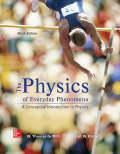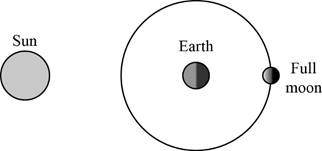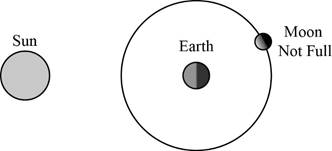
Concept explainers
The period of the moon’s orbit about the Earth is 27.3 days, but the average time between full moons is approximately 29.3 days. The difference is due to the motion of the Earth about the sun.
- a. Through what fraction of its total orbital period does the Earth move in one period of the moon’s orbit?
- b. Draw a sketch of the sun, the Earth, and the moon with the moon in the full moon condition. Then, sketch the position the moon would be in 27.3 days later, when the Earth is in its new position. If the moon is in the same position relative to Earth as it was 27.3 days earlier, is this a full moon?
- c. How much farther would the moon have to go to reach the full moon condition? Show that this represents approximately an extra two days.
(a)
The fraction of total orbital period of earth through which it move in one period of the moon’s orbit.
Answer to Problem 6SP
The fraction of total orbital period of earth through which it move in one period of the moon’s orbit is
Explanation of Solution
Given Info: The period of moon’s orbit about the Earth is
The period of orbital motion of Earth is
Write the expression for the fraction of total orbital period of Earth through which it move in one period of the moon’s orbit.
Conclusion:
Thus the fraction of total orbital period of earth through which it move in one period of the moon’s orbit is
(b)
The sketch of the sun, the Earth and the moon with the moon in the Full moon condition and also the sketch of the position where the moon would be in
Answer to Problem 6SP
The sketch of the sun, the Earth and the moon with the moon in the Full moon condition is

And the sketch of the position where the moon would be in

The moon will not be a full moon yet if the moon is in the same position relative to Earth as it was
Explanation of Solution
When the moon is full, it is on the opposite side of the Earth from the sun. The sketch of the sun, the Earth and the moon with the moon in the Full moon condition is plotted in figure 1.

Figure 1
Write the expression for the angle through which the moon or the Earth advances in one day.
Substitute
Substitute
Find the net angle through the moon advances relative to the Earth.
Find the total angle advanced by the moon in
The moon is not full moon yet.
The sketch of the position where the moon would be in

Figure 2
Conclusion:
Thus the sketch of the sun, the Earth and the moon with the moon in the Full moon condition is plotted in figure 1 and the sketch of the position where the moon would be in
(c)
The extra angle through which the moon have to go to reach the full moon condition and to show it represents approximately an extra two days.
Answer to Problem 6SP
The extra angle through which the moon have to go to reach the full moon condition is
Explanation of Solution
From part (b), the angle advanced by moon in
Find the time taken to cover
Conclusion:
Thus the extra angle through which the moon have to go to reach the full moon condition and to show it represents approximately an extra two days.
Want to see more full solutions like this?
Chapter 5 Solutions
Physics of Everyday Phenomena
- mass of 5.98 x 1024 kg. The radius of Earth 11. Sally has a mass of 50.0 kg and Earth has a mass of 5.98 × 10 kg. The radius of Earth is 6.371 x 10 m. a. What is the force of gravitational attraction between Sally and Earth? b. What is Sally's weight?arrow_forward8. The mean distance of Earth from the Sun is 149.6 x 10° km and the mean distance of Mercury from the Sun is 57.9 x 10° km. The period of Earth's revolutions is 1 year, what is the period of Mercury's revolution? a. 0.24 year on Earth b. 0.42 year on Earth C. 1.13 year on Earth d. 1.31 year on Earth 9. The planet Delta has 2 times the gravitational field strength and 3 times the radius of Earth. How does the mass of the planet Delta compare with the mass of Earth?arrow_forwardPart A Calculate the period of a satellite orbiting the Moon, 98 km above the Moon's surface. Ignore effects of the Earth. The radius of the Moon is 1740 km. Express your answer using three significant figures and include the appropriate units.arrow_forward
- The planet Mars is orbited by two small moons, Phobos and Deimos. Both moons have circular orbits. Use Kepler's Third Law in Newtonian form to compute both the product GM(Mars), where G is Newton's constant and M(Mars) is the mass of Mars, and the mass of Mars itself from the orbital data for the two moons and Newton's constant. 2. a) Phobos: P = 0.3189 days, a = 9377 km. b) Deimos: P = 1.2624 days, a = 23,460 km. %3D NOTE - The orbital periods are in earth days; 1 day = 24 hours = 86,400 s. %3D %3D Newton's constant is G = 6.673 x 10^(-11) m^3/kg s^2.arrow_forward1. The final push to the summit of Mt. Everest starts at Camp 3. Your displacement from Camp 3 to Camp 4 is 400 meter west, 600 meter south, and 100 meter up. From Camp 4 to the peak is 900 meter east, 200 meter south, and 200 meter up. a. What is the displacement from Camp 3 to the peak of Mt. Everest? Give distances east/west, north/south and up/down from Camp 3 to the peak. b. What is the straight-line distance from Camp 3 to the peak of Mt. Everest? The straight-line distance is the distance if you drew a straight line from Camp 3 to Mt. Everest.arrow_forward9. An airplane flew from Manila (14° 36'N, 121° 05'E) at a course of S 30° E maintaining a certain altitude and following a great circle path. If its groundspeed is 350 knots, after how many hours will it cross the equator? A. 2.87 hours B. 2.27 hours C. 3.17 hours D. 3.97 hours 10. Find the distance in nautical miles between Manila andarrow_forward
- What happens to the orbital velocity of an object revolving around Earth if we reduce its height to one-fourth of the original one? A. The magnitude of the orbital velocity will be quadrupled. B. The magnitude of the orbital velocity will be doubled. C. The magnitude of the orbital velocity will be reduced by a factor of 4. D. The magnitude of the orbital velocity will be halved. Determine the GPE of a 300kg-object that is 2700km above Jupiter. Mass of Jupiter = 1.898 × 10^27 kg and radius of Jupiter is 69,911 km. A. 3.25 x 10^11 J B. 4.11 x 10^13 J C. 5.23 x 10^11 J D. 1.41 x 10^13 J The handwriting or solutions please make it clear (readable) please thank youarrow_forwardAccording to Kepler's third law of planetary motion, the mean distance D, in millions of miles, from a planet in our solar system to the sun is related to the time P, in years, that it takes for the planet to complete a revolution around the sun, and the relationship is D = 93P 2/3. It takes the planet Pluto 248 years to complete a revolution around the sun. What is the mean distance from Pluto to the sun? What is the mean distance from Earth to the sun? Give your answers to the nearest million miles. from pluto to sun _____ million miles from earth to sun _____ million milesarrow_forwardMars has a mass of 6.39 × 1023 kg and radius 3.39 x 106 m. What is the magnitude of the gravitational acceleration g on Mars' surface, in m/s2? Use G = 6.67 x 10-11 N-m2/kg?. Your answer needs to have 3 significant figures, including the negative sign in your answer if needed. Do not include the positive sign if the answer is positive. No unit is needed in your answer, it is already given in the question statement.arrow_forward
- 2. The mean distance between the earth and the sun is 1.5 x 1011m. The mean distance between the sun and Venus is 1.08 x 108km. What is the period of Venus around the sun in earth- days?arrow_forward1. Compute for the value of the acceleration due to gravity g of an object at an altitude equal to twice the radius of the Earth? (radius of Earth = 6.4 x 106 m) 2. Scientists once hypothesized the existence of a planet called Vulcan to explain Mercury's precession. Vulcan is supposed to be between Mercury and the Sun with a solar distance equal to 2/3 of that of Mercury. What would be its supposed period? 3. What is the period T of a planet which radius is as twice as of Earth when it completes one revolution in 875 days? ( Earth radius = 6.38 x 105) %3D %3Darrow_forwardWhich of the following statements cannot be supported by Kepler's laws of planetary motion? a The distance of a planet around the sun changes throughout its orbit. b The speed a planet is moving around the sun changes throughout the year. c The orbital period of Mercury can be calculated using the orbital period of Jupiter and the average distances of both planets. d The age of the four largest planets can be determined using the age of the four smallest planets and the average distances of each planet.arrow_forward
 Glencoe Physics: Principles and Problems, Student...PhysicsISBN:9780078807213Author:Paul W. ZitzewitzPublisher:Glencoe/McGraw-Hill
Glencoe Physics: Principles and Problems, Student...PhysicsISBN:9780078807213Author:Paul W. ZitzewitzPublisher:Glencoe/McGraw-Hill An Introduction to Physical SciencePhysicsISBN:9781305079137Author:James Shipman, Jerry D. Wilson, Charles A. Higgins, Omar TorresPublisher:Cengage Learning
An Introduction to Physical SciencePhysicsISBN:9781305079137Author:James Shipman, Jerry D. Wilson, Charles A. Higgins, Omar TorresPublisher:Cengage Learning

